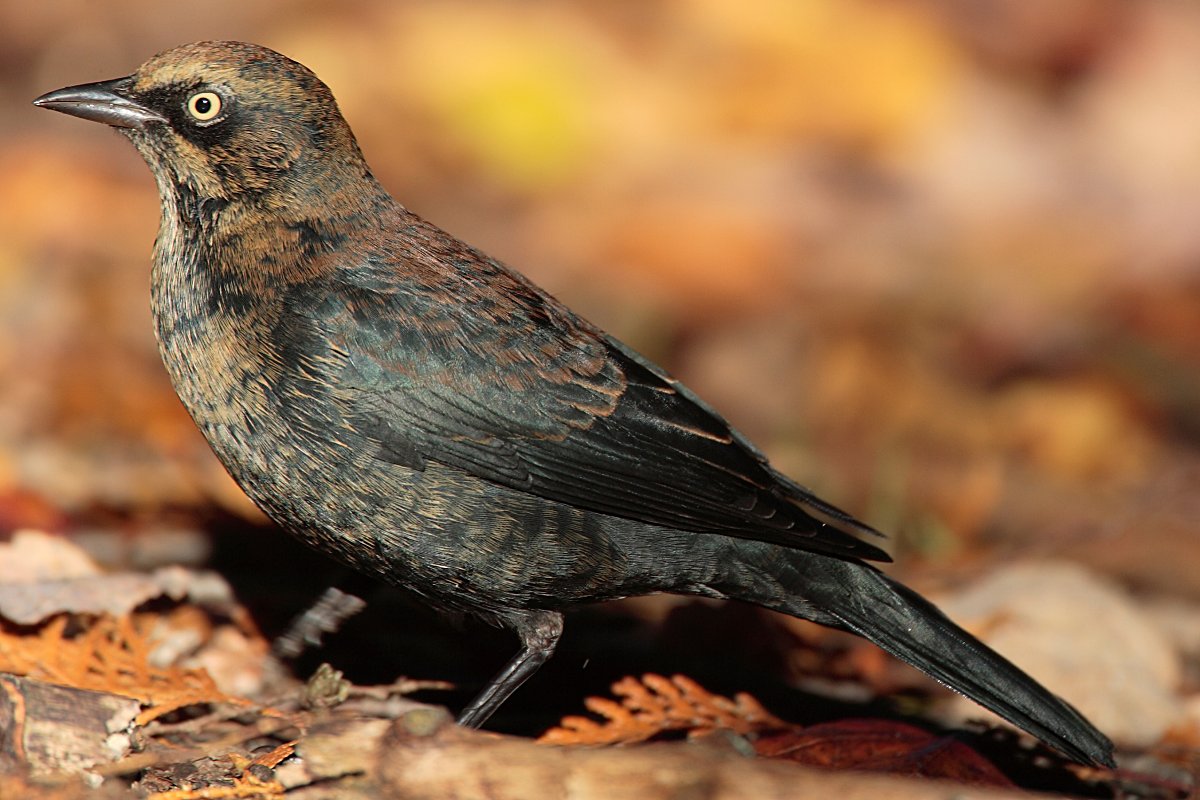Rusty Blackbird
(Euphagus carolinus)

Description
Euphagus carolinus, commonly known as the Rusty Blackbird, is a medium-sized songbird native to North America. They belong to the Icteridae family and are closely related to other blackbirds, such as the Red-winged Blackbird and the Common Grackle. In this article, we will delve into the fascinating world of the Rusty Blackbird, exploring its physical characteristics, behavior, habitat, diet, and conservation status. Physical Characteristics The Rusty Blackbird is a medium-sized bird, measuring between 8.3 and 9.4 inches (21-24 cm) in length and weighing between 1.3 and 1.9 ounces (38-55 grams). The males and females are similar in size and appearance, with both sexes displaying a glossy black plumage. As its name suggests, the Rusty Blackbird has a rusty-brown patch on its head and neck, which becomes more prominent during the breeding season. Its eyes are yellow, and its bill is sharp and pointed. Its wings are pointed, and its tail is short and slightly rounded. Habitat and Range Euphagus carolinus can be found in North America, primarily in the wetlands, bogs, and forested areas of northern Canada and Alaska during the breeding season from late April to July. During the non-breeding season, it migrates to the southeastern United States and the Gulf Coast, where it can be found in wetlands, rice paddies, and flooded agricultural fields. The Rusty Blackbird prefers to nest in areas with standing water, such as beaver ponds, marshes, and wet meadows. It requires dense vegetation for nesting and foraging and is often found in areas with tall grasses, sedges, and shrubs. During the winter, it can be found in a variety of wetland habitats, including freshwater and saltwater marshes, rice paddies, and flooded agricultural fields. It is also occasionally found in urban areas, where it feeds on insects and berries in parks and gardens. Behavior The Rusty Blackbird is primarily a solitary bird, but it may form small flocks during the non-breeding season. It is highly territorial and defends its nesting territory fiercely during the breeding season. During the breeding season, males perform elaborate courtship displays to attract females, which include fluffing up their feathers, puffing out their chests, and singing loudly. The female then selects a mate and builds a nest, which is often located in dense vegetation near water. Euphagus carolinus is a migratory bird, and it travels long distances between its breeding and wintering grounds. It is known to migrate in flocks and may form mixed-species flocks with other blackbirds during migration. The Rusty Blackbird is known to forage in the water, using its sharp bill to probe for insects and other small creatures in the mud and shallow water. It also forages in the trees and shrubs, plucking insects and fruits from the branches. Diet Euphagus carolinus is an omnivore, and its diet consists of a variety of insects, spiders, worms, and small invertebrates. It also feeds on seeds, fruits, and berries, especially during the winter months when insects are scarce. The Rusty Blackbird is known to forage in the water, using its sharp bill to probe for insects and other small creatures in the mud and shallow water. It also forages in the trees and shrubs, plucking insects and fruits from the branches. The Rusty Blackbird may also feed on agricultural crops, such as rice and corn, causing some conflicts with farmers. Breeding The Rusty Blackbird breeding season starts in late April and continues until July. During this time, males perform elaborate courtship displays to attract females, which include fluffing up their feathers, puffing out their chests, and singing loudly. After the female selects a mate, she builds a nest, which is often located in dense vegetation near water. The nest is constructed with grasses, sedges, and other plant materials and is lined with fine materials such as hair, feathers, and moss. The female lays 3-5 eggs that are a light blue-green color with dark speckles. Both the male and female take turns incubating the eggs for about 12-13 days until they hatch. The young are altricial, meaning they are born naked and with their eyes closed. They are entirely dependent on their parents for food and protection. Both parents take turns feeding and caring for the young, which fledge about 10-12 days after hatching. The young are not fully independent until several weeks after fledging, and they often stay with their parents until the next breeding season. Conservation Status The Rusty Blackbird (Euphagus carolinus) is considered a species of conservation concern, as its population has declined significantly in recent decades. According to the North American Breeding Bird Survey, the Rusty Blackbird population declined by 85% between 1966 and 2014. The exact causes of this decline are unknown, but it is believed to be related to habitat loss, climate change, and pollution. Wetland habitats, which the Rusty Blackbird depends on for nesting and foraging, have been drained or degraded by human development. Climate change is affecting the timing of spring migration, which can cause the birds to arrive at their breeding grounds too early or too late for optimal breeding success. Pollutants such as mercury can also accumulate in the birds' food chain, causing health problems and reproductive failure. Conservation efforts are underway to protect the Rusty Blackbird and its habitat. The Rusty Blackbird Conservation Initiative, launched in 2005, is a collaborative effort between scientists, conservationists, and volunteers to raise awareness of the bird's plight and to collect data on its habitat use, behavior, and migration. Habitat restoration projects, such as the creation of wetlands and the preservation of forested areas, are also being implemented to provide suitable habitat for the Rusty Blackbird. Additionally, reducing pollution and mitigating the effects of climate change can help ensure the survival of this species.
Taxonomic tree:







